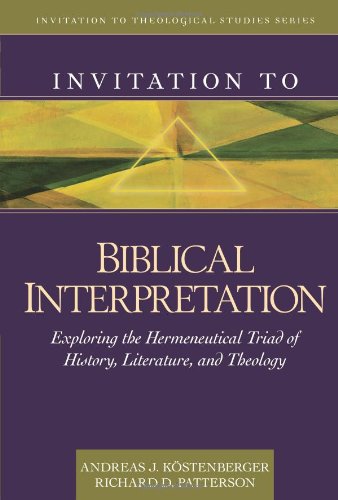A Brief Book Notice from Books At a Glance
By Fred Zaspel
I recently had occasion again to look through this 2011 textbook, and I was struck with its value. I can’t imagine who wouldn’t profit from this work. The “triad” in view, as the subtitle states, is history, literature, and theology. These important considerations for biblical interpretation are not new with Köstenberger and Patterson, but they do seem to work it out in more pointed detail.
With “history” and background up front and “theology” (“the goal”) and “application” at the end, their treatment of the biblical “literature” in between takes up the bulk of the book. Under this category (as you can see in the Table of Contents below) they proceed from big picture (Canon) to literary style (Genre) and then finally to the meanings and relations of words (Language). This approach – from the forest to the trees – serves the reader well as he/she comes to learn how to handle the particulars only with the larger shape and story of the Bible in mind.
The big picture (“Canon”) Köstenberger and Patterson present here sketches out major themes of Law, Exodus, Covenant, Messiah, Fulfillment, Righteousness & Faith, and so on, providing the reader with a firm grasp of the major structures and trajectories under which the Bible story unfolds. “Genre” of course introduces and explores the major divisions of the Old and New Testaments respectively (Law, History, Wisdom & Poetry, Prophets, etc.). And under “Language” the authors provide specific instruction on understanding the meanings of words, grammar, syntax, figurative language, and so on. Their instruction throughout is well-informed and insightful
Köstenberger and Patterson bring all this together under “Theology” and “Application” – the end game of Bible study. Their concentrated focus on Biblical Theology helpfully directs us to read the Bible on its own terms in the unfolding of its story and message. And their guidance to apply Scripture accurately and faithfully rounds out their “Invitation” to profitable biblical interpretation.
It should be obvious enough that if we are to profit from the Bible we must understand it – and understand it correctly. And there really are interpretive processes that can reliably guide us to understand the Bible correctly. Köstenberger and Patterson start us on that path remarkably well, sharing enlightening insights at every turn.
Invitation to Biblical Interpretation is a first class resource that’s been around a few years. We normally feature newer titles here on Books At a Glance, but we try also to feature previously published books that are deserving of mention. This is certainly one such book. As I said at the top – I can’t imagine anyone who wouldn’t profit from this book.
Note also that TGC Learn has just launched a course around this book. See here, where Dr. Köstenberger will walk you through the book section by section.
Table of Contents
Preparation: The Who, Why, and How of Interpretation
Chapter 1: Introduction to the Hermeneutical Triad
Interpretation: The Hermeneutical Triad
PART I: The Context of Scripture: History
Chapter 2: Setting the Stage: Historical Cultural Background
PART II: The Focus of Scripture: Literature
Unit 1: Canon
Chapter 3: The Old Testament Canon: The Law, the Prophets, and the Writings
Chapter 4: The New Testament Canon: The Gospels, Acts, Epistles, and Revelation
Unit 2: Genre
Chapter 5: Enjoying God’s Story: Old Testament Historical Narrative
Chapter 6: A Word from the Wise: Poetry and Wisdom
Chapter 7: Back to the Future: Poetry
Chapter 8: Hearing the Good News: New Testament Historical Narrative (Gospels & Actrs)
Chapter 9: Calling for Discernment: Parables
Chapter 10: Going by the Letter: Epistles
Chapter 11: Visions of the End: Apocalyptic Literature (Revelation)
Unit 3: Language
Chapter 12: The Importance of Context: Grammar, Syntax, and Discourse
Chapter 13: The Meaning of Words: Linguistics, Semantics, and Exegetical Fallacies
Chapter 14: A Way of Speaking: Figurative Language
PART III: The Goal: Theology
Chapter 15: Making the Connection: Getting our Theology from the Bible
Application and Proclamation: God’s Word Coming to Life
Chapter 16: Getting Down to Earth: Using the Tools, Preaching and Applying the Word
Buy the books

Invitation to Biblical Interpretation: Exploring the Hermeneutical Triad of History, Literature, and Theology